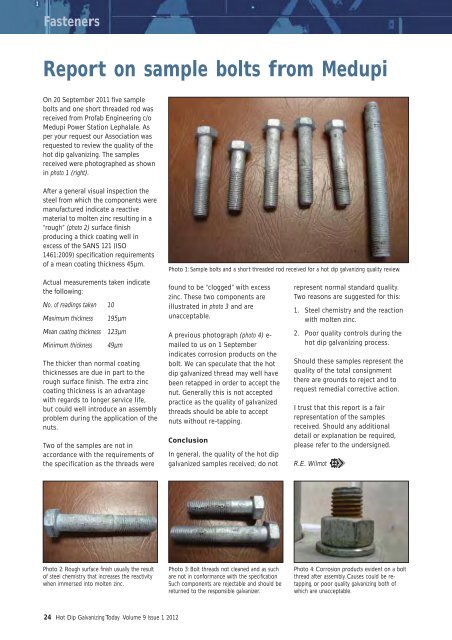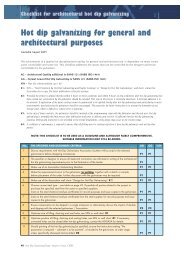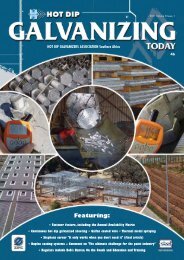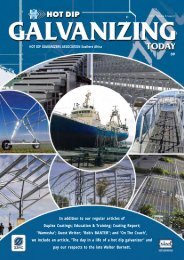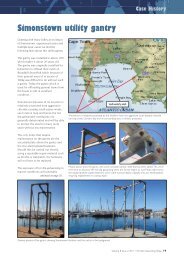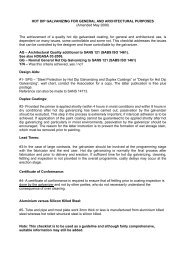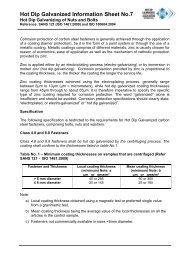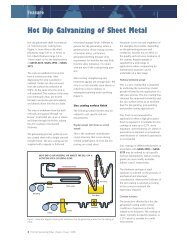Fasteners - hdgasa
Fasteners - hdgasa
Fasteners - hdgasa
Create successful ePaper yourself
Turn your PDF publications into a flip-book with our unique Google optimized e-Paper software.
<strong>Fasteners</strong><br />
Report on sample bolts from Medupi<br />
On 20 September 2011 five sample<br />
bolts and one short threaded rod was<br />
received from Profab Engineering c/o<br />
Medupi Power Station Lephalale. As<br />
per your request our Association was<br />
requested to review the quality of the<br />
hot dip galvanizing. The samples<br />
received were photographed as shown<br />
in photo 1 (right).<br />
After a general visual inspection the<br />
steel from which the components were<br />
manufactured indicate a reactive<br />
material to molten zinc resulting in a<br />
“rough” (photo 2) surface finish<br />
producing a thick coating well in<br />
excess of the SANS 121 (ISO<br />
1461:2009) specification requirements<br />
of a mean coating thickness 45µm.<br />
Photo 1: Sample bolts and a short threaded rod received for a hot dip galvanizing quality review.<br />
Actual measurements taken indicate<br />
the following:<br />
No. of readings taken 10<br />
Maximum thickness 195µm<br />
Mean coating thickness 123µm<br />
Minimum thickness 49µm<br />
The thicker than normal coating<br />
thicknesses are due in part to the<br />
rough surface finish. The extra zinc<br />
coating thickness is an advantage<br />
with regards to longer service life,<br />
but could well introduce an assembly<br />
problem during the application of the<br />
nuts.<br />
Two of the samples are not in<br />
accordance with the requirements of<br />
the specification as the threads were<br />
found to be “clogged” with excess<br />
zinc. These two components are<br />
illustrated in photo 3 and are<br />
unacceptable.<br />
A previous photograph (photo 4) e-<br />
mailed to us on 1 September<br />
indicates corrosion products on the<br />
bolt. We can speculate that the hot<br />
dip galvanized thread may well have<br />
been retapped in order to accept the<br />
nut. Generally this is not accepted<br />
practice as the quality of galvanized<br />
threads should be able to accept<br />
nuts without re-tapping.<br />
Conclusion<br />
In general, the quality of the hot dip<br />
galvanized samples received; do not<br />
represent normal standard quality.<br />
Two reasons are suggested for this:<br />
1. Steel chemistry and the reaction<br />
with molten zinc.<br />
2. Poor quality controls during the<br />
hot dip galvanizing process.<br />
Should these samples represent the<br />
quality of the total consignment<br />
there are grounds to reject and to<br />
request remedial corrective action.<br />
I trust that this report is a fair<br />
representation of the samples<br />
received. Should any additional<br />
detail or explanation be required,<br />
please refer to the undersigned.<br />
R.E. Wilmot<br />
Photo 2: Rough surface finish usually the result<br />
of steel chemistry that increases the reactivity<br />
when immersed into molten zinc.<br />
Photo 3: Bolt threads not cleaned and as such<br />
are not in conformance with the specification<br />
Such components are rejectable and should be<br />
returned to the responsible galvanizer.<br />
Photo 4: Corrosion products evident on a bolt<br />
thread after assembly. Causes could be retapping,<br />
or poor quality galvanizing both of<br />
which are unacceptable.<br />
24 Hot Dip Galvanizing Today Volume 9 Issue 1 2012


